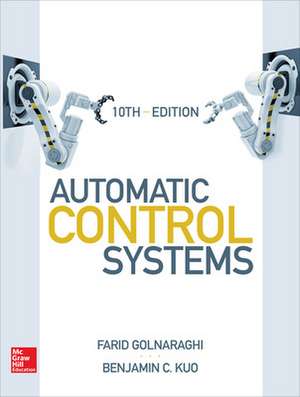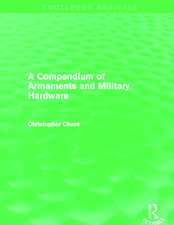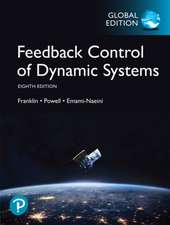Automatic Control Systems, Tenth Edition
Autor Farid Golnaraghi, Benjamin Kuoen Limba Engleză Hardback – 16 mar 2017
The classic text on control systems – completely updated and revised for the most student-friendly edition ever
This completely overhauled Tenth Edition of the renowned textbook delivers practical coverage designed to introduce readers to the essential concepts of automatic control systems without bogging them down with theoretical complexities. Enhanced by all-new chapters, a greater number of solved examples, labs using both LEGO Mindstorms® and MATLAB/SIMLab, and a valuable introduction to the concept of ControlLab, the book provides students with a real-world understanding of the subject and prepares them for the challenges they will one day face.
FEATURES
• Most chapters have been completely revised with new problems and worked examples throughout
• Provides real-world, hands-on application using LEGOLab
• Thoroughly revised to be more practical and student friendly
• A full set of PowerPoint slides and solutions are available to instructors
Preț: 1114.62 lei
Preț vechi: 1616.10 lei
-31% Nou
213.31€ • 221.88$ • 176.10£
Carte tipărită la comandă
Livrare economică 11-22 aprilie
Specificații
ISBN-10: 1259643832
Pagini: 864
Dimensiuni: 211 x 254 x 46 mm
Greutate: 1.68 kg
Ediția:10
Editura: McGraw Hill Education
Colecția McGraw-Hill
Locul publicării:United States
Cuprins
CHAPTER 1 Introduction to Control Systems
1-1 Basic Components of a Control System
1-2 Examples of Control-System Applications
1-2-1 Intelligent Transportation Systems
1-2-2 Steering Control of an Automobile
1-2-3 Idle-Speed Control of an Automobile
1-2-4 Sun-Tracking Control of Solar Collectors
1-3 Open-Loop Control Systems (Nonfeedback Systems)
1-4 Closed-Loop Control Systems (Feedback Control Systems)
1-5 What Is Feedback, and What Are Its Effects?
1-5-1 Effect of Feedback on Overall Gain
1-5-2 Effect of Feedback on Stability
1-5-3 Effect of Feedback on External Disturbance or Noise
1-6 Types of Feedback Control Systems
1-7 Linear versus Nonlinear Control Systems
1-8 Time-Invariant versus Time-Varying Systems
1-9 Continuous-Data Control Systems
1-10 Discrete-Data Control Systems
1-11 Case Study: Intelligent Vehicle Obstacle Avoidance—LEGO MINDSTORMS
1-12 Summary
CHAPTER 2 Modeling of Dynamic Systems
2-1 Modeling of Simple Mechanical Systems
2-1-1 Translational Motion
2-1-2 Rotational Motion
2-1-3 Conversion between Translational and Rotational Motions
2-1-4 Gear Trains
2-1-5 Backlash and Dead Zone (Nonlinear Characteristics)
2-2 Introduction to Modeling of Simple Electrical Systems
2-2-1 Modeling of Passive Electrical Elements
2-2-2 Modeling of Electrical Networks
2-3 Introduction to Modeling of Thermal and Fluid Systems
2-3-1 Elementary Heat Transfer Properties
2-3-2 Elementary Fluid System Properties
2-4 Linearization of Nonlinear Systems
2-4-1 Linearization Using Taylor Series: Classical Representation
2-5 Analogies
2-6 Project: Introduction to LEGO MINDSTORMS NXT Motor—Mechanical Modeling
2-7 Summary
References
Problems
CHAPTER 3 Solution of Differential Equations of Dynamic Systems
3-1 Introduction to Differential Equations
3-1-1 Linear Ordinary Differential Equations
3-1-2 Nonlinear Differential Equations
3-2 Laplace Transform
3-2-1 Definition of the Laplace Transform
3-2-2 Important Theorems of the Laplace Transform
3-2-3 Transfer Function
3-2-4 Characteristic Equation
3-2-5 Analytic Function
3-2-6 Poles of a Function
3-2-7 Zeros of a Function
3-2-8 Complex Conjugate Poles and Zeros
3-2-9 Final-Value Theorem
3-3 Inverse Laplace Transform by Partial-Fraction Expansion
3-3-1 Partial Fraction Expansion
3-4 Application of the Laplace Transform to the Solution of Linear Ordinary Differential Equations
3-4-1 First-Order Prototype System
3-4-2 Second-Order Prototype System
3-4-3 Second-Order Prototype System—Final Observations
3-5 Impulse Response and Transfer Functions of Linear Systems
3-5-1 Impulse Response
3-5-2 Time Response Using the Impulse Response
3-5-3 Transfer Function (Single-Input, Single-Output Systems)
3-6 Systems of First-Order Differential Equations: State Equations
3-6-1 Definition of State Variables
3-6-2 The Output Equation
3-7 Solution of the Linear Homogeneous State Equation
3-7-1 Transfer Functions (Multivariable Systems)
3-7-2 Characteristic Equation from State Equations
3-7-3 State Equations from the Transfer Function
3-8 Case Studies with MATLAB
3-9 Linearization Revisited—the State-Space Approach
3-10 Summary
References
Problems
CHAPTER 4 Block Diagrams and Signal-Flow Graphs
4-1 Block Diagrams
4-1-1 Modeling of Typical Elements of Block Diagrams in Control Systems
4-1-2 Relation between Mathematical Equations and Block Diagrams
4-1-3 Block Diagram Reduction
4-1-4 Block Diagrams of Multi-Input Systems: Special Case—Systems with a Disturbance
4-1-5 Block Diagrams and Transfer Functions of Multivariable Systems
4-2 Signal-Flow Graphs
4-2-1 SFG Algebra
4-2-2 Definitions of SFG Terms
4-2-3 Gain Formula for SFG
4-2-4 Application of the Gain Formula between Output Nodes and Noninput Nodes
4-2-5 Simplified Gain Formula
4-3 State Diagram
4-3-1 From Differential Equations to State Diagrams
4-3-2 From State Diagrams to Transfer Functions
4-3-3 From State Diagrams to State and Output Equations
4-4 Case Studies
4-5 MATLAB Tools
4-6 Summary
References
Problems
CHAPTER 5 Stability of Linear Control Systems
5-1 Introduction to Stability
5-2 Methods of Determining Stability
5-3 Routh-Hurwitz Criterion
5-3-1 Routh’s Tabulation
5-3-2 Special Cases When Routh’s Tabulation Terminates Prematurely
5-4 MATLAB Tools and Case Studies
5-5 Summary
References
Problems
CHAPTER 6 Important Components of Feedback Control Systems
6-1 Modeling of Active Electrical Elements: Operational Amplifiers
6-1-1 The Ideal Op-Amp
6-1-2 Sums and Differences
6-1-3 First-Order Op-Amp Configurations
6-2 Sensors and Encoders in Control Systems
6-2-1 Potentiometer
6-2-2 Tachometers
6-2-3 Incremental Encoder
6-3 DC Motors in Control Systems
6-3-1 Basic Operational Principles of DC Motors
6-3-2 Basic Classifications of PM DC Motors
6-3-3 Surface-Wound DC Motors
6-3-4 Moving-Coil DC Motors
6-3-5 Brushless DC Motors
6-3-6 Mathematical Modeling of PM DC Motors
6-3-7 Relation between Ki and Kb
6-4 Speed and Position Control of a DC Motor
6-4-1 Speed Response and the Effects of Inductance and Disturbance: Open-Loop Response
6-4-2 Speed Control of DC Motors: Closed-Loop Response
6-4-3 Position Control
6-5 Case Studies: Practical Examples
6-6 The Control Lab: Introduction to LEGO MINDSTORMS NXT Motor—Modeling and Characterization
6-6-1 NXT Motor
6-6-2 Electrical Characteristics
6-6-3 Mechanical Characteristics
6-6-4 Speed Response and Model Verification
6-7 Summary
References
Problems
CHAPTER 7 Time-Domain Performance of Control Systems
7-1 Time Response of Continuous-Data Systems: Introduction
7-2 Typical Test Signals to Evaluate Time-Response Performance of Control Systems
7-3 The Unit-Step Response and Time-Domain Specifications
7-4 Time Response of a Prototype First-Order System
7-5 Transient Response of a Prototype Second-Order System
7-5-1 Damping Ratio and Natural Frequency
7-5-2 Maximum Overshoot (0 < ζ < 1)
7-5-3 Delay Time and Rise Time (0 < ζ < 1)
7-5-4 Settling Time (5 and 2 Percent)
7-5-5 Transient Response Performance Criteria—Final Remarks
7-6 Steady-State Error
7-6-1 Definition of the Steady-State Error
7-6-2 Steady-State Error in Systems with a Disturbance
7-6-3 Types of Control Systems: Unity-Feedback Systems
7-6-4 Error Constants
7-6-5 Steady-State Error Caused by Nonlinear System Elements
7-7 Basic Control Systems and Effects of Adding Poles and Zeros to Transfer Functions
7-7-1 Addition of a Pole to the Forward-Path Transfer Function: Unity-Feedback Systems
7-7-2 Addition of a Pole to the Closed-Loop Transfer Function
7-7-3 Addition of a Zero to the Closed-Loop Transfer Function
7-7-4 Addition of a Zero to the Forward-Path Transfer Function: Unity-Feedback Systems
7-7-5 Addition of Poles and Zeros: Introduction to Control of Time Response
7-8 Dominant Poles and Zeros of Transfer Functions
7-8-1 Summary of Effects of Poles and Zeros
7-8-2 The Relative Damping Ratio
7-8-3 The Proper Way of Neglecting the Insignificant Poles with Consideration of the Steady-State Response
7-9 Case Study: Time-Domain Analysis of a Position-Control System
7-9-1 Unit-Step Transient Response
7-9-2 The Steady-State Response
7-9-3 Time Response of a Third-Order System—Electrical Time Constant Not Neglected
7-9-4 Unit-Step Transient Response
7-9-5 Steady-State Response
7-10 The Control Lab: Introduction to LEGO MINDSTORMS NXT Motor—Position Control
7-11 Summary
References
Problems
CHAPTER 8 State-Space Analysis and Controller Design
8-1 State-Variable Analysis
8-2 Block Diagrams, Transfer Functions, and State Diagrams
8-2-1 Transfer Functions (Multivariable Systems)
8-2-2 Block Diagrams and Transfer Functions of Multivariable Systems
8-3 Systems of First-Order Differential Equations: State Equations
8-3-1 Definition of State Variables
8-3-2 The Output Equation
8-4 Vector-Matrix Representation of State Equations
8-5 State-Transition Matrix
8-5-1 Significance of the State-Transition Matrix
8-5-2 Properties of the State-Transition Matrix
8-6 State-Transition Equation
8-6-1 State-Transition Equation Determined from the State Diagram
8-7 Relationship between State Equations and High-Order Differential Equations
8-8 Relationship between State Equations and Transfer Functions
8-9 Characteristic Equations, Eigenvalues, and Eigenvectors
8-9-1 Characteristic Equation from a Differential Equation
8-9-2 Characteristic Equation from a Transfer Function
8-9-3 Characteristic Equation from State Equations
8-9-4 Eigenvalues
8-9-5 Eigenvectors
8-9-6 Generalized Eigenvectors
8-10 Similarity Transformation
8-10-1 Invariance Properties of the Similarity Transformations
8-10-2 Characteristic Equations, Eigenvalues, and Eigenvectors
8-10-3 Transfer-Function Matrix
8-10-4 Controllability Canonical Form
8-10-5 Observability Canonical Form
8-10-6 Diagonal Canonical Form
8-10-7 Jordan Canonical Form
8-11 Decompositions of Transfer Functions
8-11-1 Direct Decomposition
8-11-2 Direct Decomposition to CCF
8-11-3 Direct Decomposition to OCF
8-11-4 Cascade Decomposition
8-11-5 Parallel Decomposition
8-12 Controllability of Control Systems
8-12-1 General Concept of Controllability
8-12-2 Definition of State Controllability
8-12-3 Alternate Tests on Controllability
8-13 Observability of Linear Systems
8-13-1 Definition of Observability
8-13-2 Alternate Tests on Observability
8-14 Relationship among Controllability, Observability, and Transfer Functions
8-15 Invariant Theorems on Controllability and Observability
8-16 Case Study: Magnetic-Ball Suspension System
8-16-1 The Characteristic Equation
8-17 State-Feedback Control
8-18 Pole-Placement Design through State Feedback
8-19 State Feedback with Integral Control
8-20 MATLAB Tools and Case Studies
8-20-1 Description and Use of the State-Space Analysis Tool
8-20-2 Description and Use of tfsym for State-Space Applications
8-21 Case Study: Position Control of the LEGO MINDSTORMS Robotic Arm System
8-22 Summary
References
Problems
CHAPTER 9 Root-Locus Analysis
9-1 Basic Properties of the Root Loci
9-2 Properties of the Root Loci
9-2-1 K = 0 and K = ±∞ Points
9-2-2 Number of Branches on the Root Loci
9-2-3 Symmetry of the RL
9-2-4 Angles of Asymptotes of the RL: Behavior of the RL at |s| = ∞
9-2-5 Intersect of the Asymptotes (Centroid)
9-2-6 Root Loci on the Real Axis
9-2-7 Angles of Departure and Angles of Arrival of the RL
9-2-8 Intersection of the RL with the Imaginary Axis
9-2-9 Breakaway Points (Saddle Points) on the RL
9-2-10 Angles of Arrival and Departure of Root Loci at the Breakaway Point
9-2-11 Calculation of K on the Root Loci
9-2-12 Summary: Properties of the Root Loci
9-3 The Root Sensitivity
9-4 Design Aspects of the Root Loci
9-4-1 Effects of Adding Poles and Zeros to G(s)H(s)
9-4-2 Addition of Poles to G(s)H(s)
9-4-3 Addition of Zeros to G(s)H(s)
9-5 Root Contours: Multiple-Parameter Variation
9-6 MATLAB Tools
9-7 Summary
References
Problems
CHAPTER 10 Frequency-Domain Analysis
10-1 Introduction to Frequency Response
10-1-1 Frequency Response of Closed-Loop Systems
10-1-2 Frequency-Domain Specifications
10-2 Mr, ωr, and Bandwidth of the Prototype Second-Order System
10-2-1 Resonant Peak and Resonant Frequency
10-2-2 Bandwidth
10-3 Effects of Adding Poles and Zeros to the Forward-Path Transfer Function
10-3-1 Effects of Adding a Zero to the Forward-Path Transfer Function
10-3-2 Effects of Adding a Pole to the Forward-Path Transfer Function
10-4 Nyquist Stability Criterion: Fundamentals
10-4-1 Stability Problem
10-4-2 Definitions of Encircled and Enclosed
10-4-3 Number of Encirclements and Enclosures
10-4-4 Principles of the Argument
10-4-5 Nyquist Path
10-4-6 Nyquist Criterion and the L(s) or the G(s)H(s) Plot
10-5 Nyquist Criterion for Systems with Minimum-Phase Transfer Functions
10-5-1 Application of the Nyquist Criterion to Minimum-Phase Transfer Functions That Are Not Strictly Proper
10-6 Relation between the Root Loci and the Nyquist Plot
10-7 Illustrative Examples: Nyquist Criterion for Minimum-Phase Transfer Functions
10-8 Effects of Adding Poles and Zeros to L(s) on the Shape of the Nyquist Plot
10-8-1 Addition of Poles at s = 0
10-8-2 Addition of Finite Nonzero Poles
10-8-3 Addition of Zeros
10-9 Relative Stability: Gain Margin and Phase Margin
10-9-1 Gain Margin
10-9-2 Gain Margin of Nonminimum-Phase Systems
10-9-3 Phase Margin
10-10 Stability Analysis with the Bode Plot
10-10-1 Bode Plots of Systems with Pure Time Delays
10-11 Relative Stability Related to the Slope of the Magnitude Curve of the Bode Plot
10-11-1 Conditionally Stable System
10-12 Stability Analysis with the Magnitude-Phase Plot
10-13 Constant-M Loci in the Magnitude-Phase Plane: The Nichols Chart
10-14 Nichols Chart Applied to Nonunity-Feedback Systems
10-15 Sensitivity Studies in the Frequency Domain
10-16 MATLAB Tools and Case Studies
10-17 Summary
References
Problems
CHAPTER 11 Design of Control Systems
11-1 Introduction
11-1-1 Design Specifications
11-1-2 Controller Configurations
11-1-3 Fundamental Principles of Design
11-2 Design with the PD Controller
11-2-1 Time-Domain Interpretation of PD Control
11-2-2 Frequency-Domain Interpretation of PD Control
11-2-3 Summary of Effects of PD Control
11-3 Design with the PI Controller
11-3-1 Time-Domain Interpretation and Design of PI Control
11-3-2 Frequency-Domain Interpretation and Design of PI Control
11-4 Design with the PID Controller
11-5 Design with Phase-Lead and Phase-Lag Controllers
11-5-1 Time-Domain Interpretation and Design of Phase-Lead Control
11-5-2 Frequency-Domain Interpretation and Design of Phase-Lead Control
11-5-3 Effects of Phase-Lead Compensation
11-5-4 Limitations of Single-Stage Phase-Lead Control
11-5-5 Multistage Phase-Lead Controller
11-5-6 Sensitivity Considerations
11-5-7 Time-Domain Interpretation and Design of Phase-Lag Control
11-5-8 Frequency-Domain Interpretation and Design of Phase-Lag Control
11-5-9 Effects and Limitations of Phase-Lag Control
11-5-10 Design with Lead-Lag Controller
11-6 Pole-Zero-Cancellation Design: Notch Filter
11-6-1 Second-Order Active Filter
11-6-2 Frequency-Domain Interpretation and Design
11-7 Forward and Feedforward Controllers
11-8 Design of Robust Control Systems
11-9 Minor-Loop Feedback Control
11-9-1 Rate-Feedback or Tachometer-Feedback Control
11-9-2 Minor-Loop Feedback Control with Active Filter
11-10 MATLAB Tools and Case Studies
11-11 The Control Lab
References
Problems
INDEX
Descriere
The classic text on control systems – completely updated and revised for the most student-friendly edition ever
This completely overhauled Tenth Edition of the renowned textbook delivers practical coverage designed to introduce readers to the essential concepts of automatic control systems without bogging them down with theoretical complexities. Enhanced by all-new chapters, a greater number of solved examples, labs using both LEGO Mindstorms® and MATLAB/SIMLab, and a valuable introduction to the concept of ControlLab, the book provides students with a real-world understanding of the subject and prepares them for the challenges they will one day face.
FEATURES
• Most chapters have been completely revised with new problems and worked examples throughout
• Provides real-world, hands-on application using LEGOLab
• Thoroughly revised to be more practical and student friendly
• A full set of PowerPoint slides and solutions are available to instructors




















